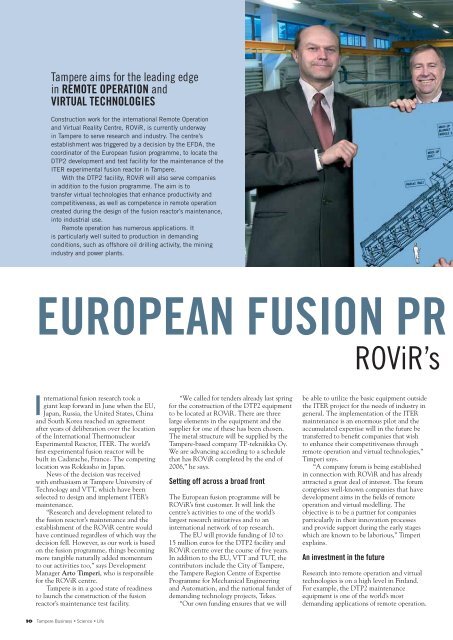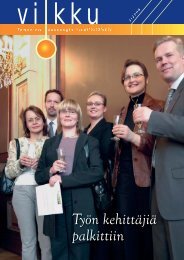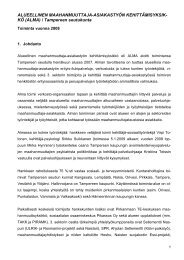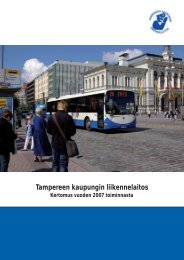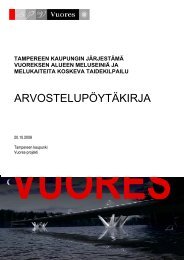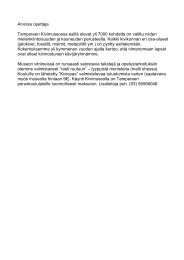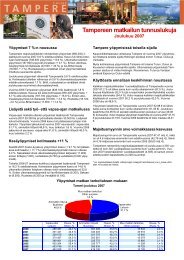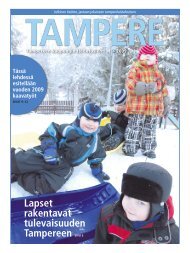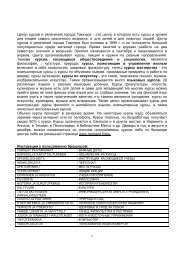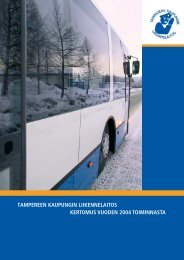- Tampere seizes creative economy
- Tampere seizes creative economy
- Tampere seizes creative economy
Create successful ePaper yourself
Turn your PDF publications into a flip-book with our unique Google optimized e-Paper software.
<strong>Tampere</strong> aims for the leading edge<br />
in REMOTE OPERATION and<br />
VIRTUAL TECHNOLOGIES<br />
Construction work for the international Remote Operation<br />
and Virtual Reality Centre, ROViR, is currently underway<br />
in <strong>Tampere</strong> to serve research and industry. The centre’s<br />
establishment was triggered by a decision by the EFDA, the<br />
coordinator of the European fusion programme, to locate the<br />
DTP2 development and test facility for the maintenance of the<br />
ITER experimental fusion reactor in <strong>Tampere</strong>.<br />
With the DTP2 facility, ROViR will also serve companies<br />
in addition to the fusion programme. The aim is to<br />
transfer virtual technologies that enhance productivity and<br />
competitiveness, as well as competence in remote operation<br />
created during the design of the fusion reactor’s maintenance,<br />
into industrial use.<br />
Remote operation has numerous applications. It<br />
is particularly well suited to production in demanding<br />
conditions, such as offshore oil drilling activity, the mining<br />
industry and power plants.<br />
EUROPEAN FUSION PR<br />
ROViR’s<br />
International fusion research took a<br />
giant leap forward in June when the EU,<br />
Japan, Russia, the United States, China<br />
and South Korea reached an agreement<br />
after years of deliberation over the location<br />
of the International Thermonuclear<br />
Experimental Reactor, ITER. The world’s<br />
fi rst experimental fusion reactor will be<br />
built in Cadarache, France. The competing<br />
location was Rokkasho in Japan.<br />
News of the decision was received<br />
with enthusiasm at <strong>Tampere</strong> University of<br />
Technology and VTT, which have been<br />
selected to design and implement ITER’s<br />
maintenance.<br />
“Research and development related to<br />
the fusion reactor’s maintenance and the<br />
establishment of the ROViR centre would<br />
have continued regardless of which way the<br />
decision fell. However, as our work is based<br />
on the fusion programme, things becoming<br />
more tangible naturally added momentum<br />
to our activities too,” says Development<br />
Manager Arto Timperi, who is responsible<br />
for the ROViR centre.<br />
<strong>Tampere</strong> is in a good state of readiness<br />
to launch the construction of the fusion<br />
reactor’s maintenance test facility.<br />
“We called for tenders already last spring<br />
for the construction of the DTP2 equipment<br />
to be located at ROViR. There are three<br />
large elements in the equipment and the<br />
supplier for one of these has been chosen.<br />
The metal structure will be supplied by the<br />
<strong>Tampere</strong>-based company TP-tekniikka Oy.<br />
We are advancing according to a schedule<br />
that has ROViR completed by the end of<br />
2006,” he says.<br />
Setting off across a broad front<br />
The European fusion programme will be<br />
ROViR’s fi rst customer. It will link the<br />
centre’s activities to one of the world’s<br />
largest research initiatives and to an<br />
international network of top research.<br />
The EU will provide funding of 10 to<br />
15 million euros for the DTP2 facility and<br />
ROViR centre over the course of fi ve years.<br />
In addition to the EU, VTT and TUT, the<br />
contributors include the City of <strong>Tampere</strong>,<br />
the <strong>Tampere</strong> Region Centre of Expertise<br />
Programme for Mechanical Engineering<br />
and Automation, and the national funder of<br />
demanding technology projects, Tekes.<br />
“Our own funding ensures that we will<br />
be able to utilize the basic equipment outside<br />
the ITER project for the needs of industry in<br />
general. The implementation of the ITER<br />
maintenance is an enormous pilot and the<br />
accumulated expertise will in the future be<br />
transferred to benefi t companies that wish<br />
to enhance their competitiveness through<br />
remote operation and virtual technologies,”<br />
Timperi says.<br />
“A company forum is being established<br />
in connection with ROViR and has already<br />
attracted a great deal of interest. The forum<br />
comprises well-known companies that have<br />
development aims in the fi elds of remote<br />
operation and virtual modelling. The<br />
objective is to be a partner for companies<br />
particularly in their innovation processes<br />
and provide support during the early stages<br />
which are known to be laborious,” Timperi<br />
explains.<br />
An investment in the future<br />
Research into remote operation and virtual<br />
technologies is on a high level in Finland.<br />
For example, the DTP2 maintenance<br />
equipment is one of the world’s most<br />
demanding applications of remote operation.<br />
10 <strong>Tampere</strong> Business • Science • Life


